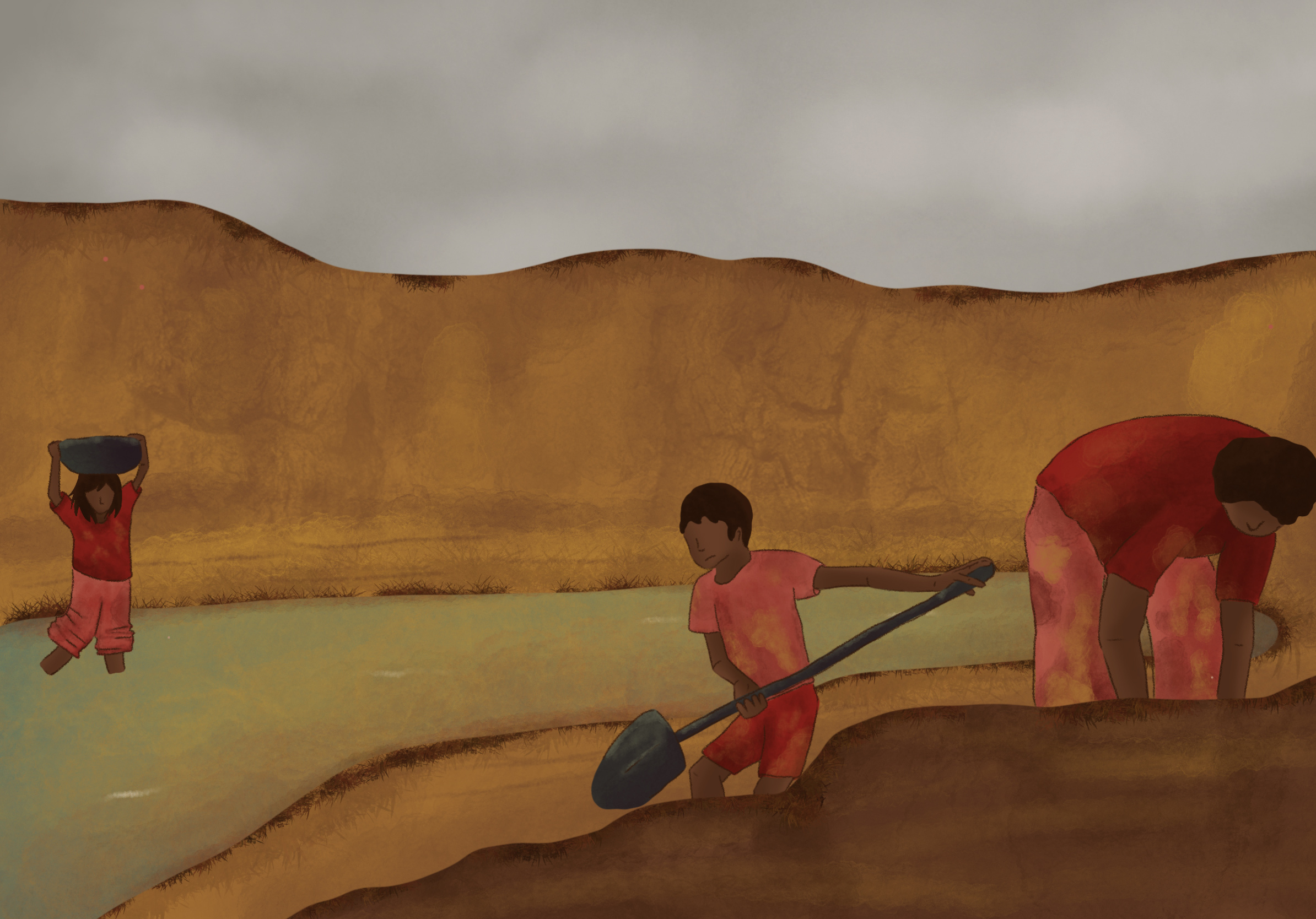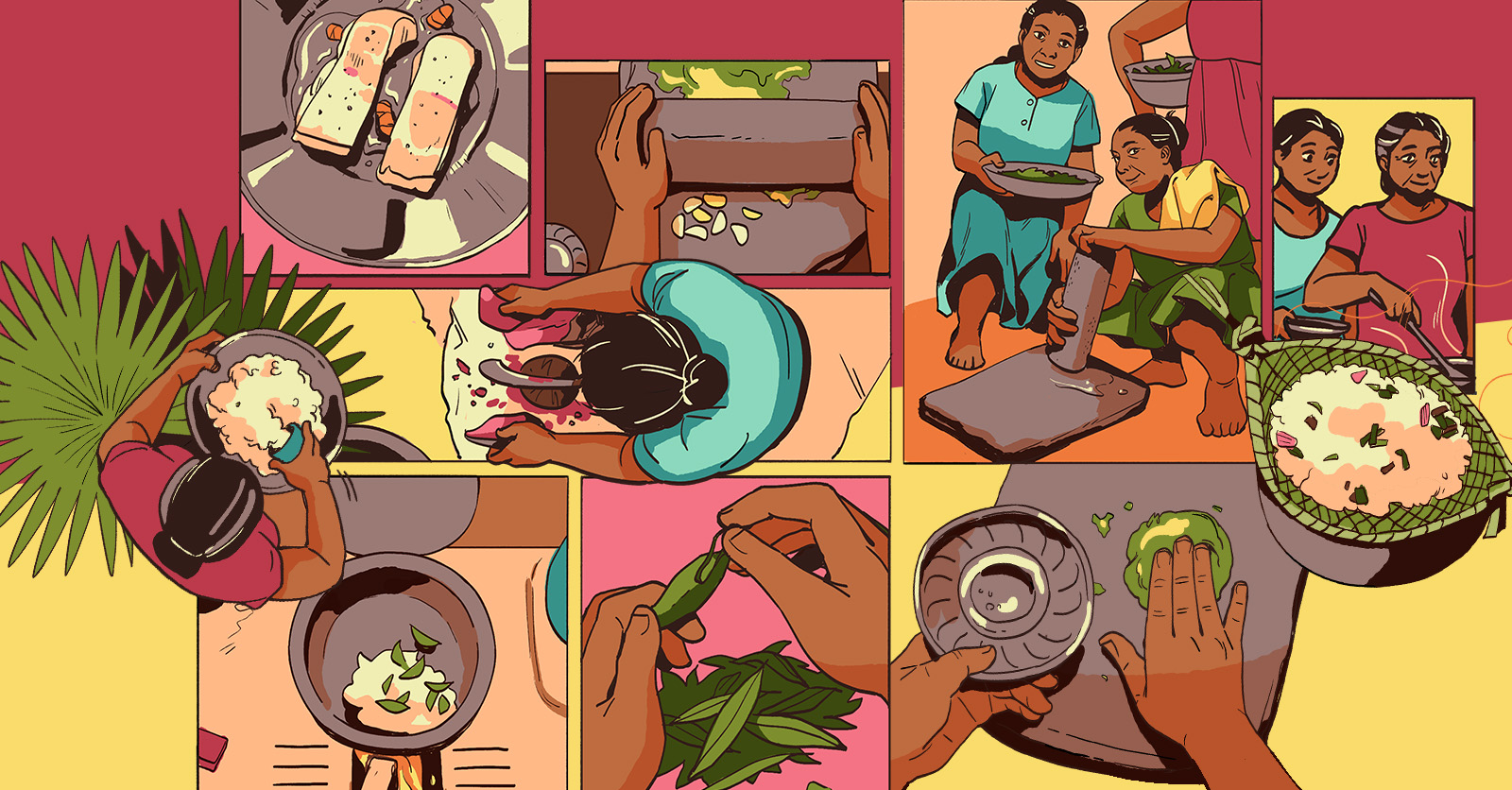Nature’s Utensils
How traditional kitchen tools shape nourishment in Sri Lanka
by Taahira AyoobModern kitchen tools cater to the convenience, aesthetics, and durability desired in today’s world, but what do we lose from moving away from natural utensils?
About one-third of the world’s population eats with their hands. Do you? This simple, instinctive act turns a meal into a full-bodied experience.
Long before utensils, hands were our primary eating tools, often supplemented with natural items like leaves and hollowed gourds. Knives emerged approximately 2.5 million years ago around the Lower Palaeolithic period, initially as tools for hunting, and later for food preparation. For liquids, spoons were crafted from wood or seashells in Egypt and Mesopotamia as early as 1000 BCE. Forks were the last to arrive, gaining widespread use during the European Renaissance in the 16th century, symbolising refinement and etiquette.
Much of how we eat today has evolved, but in many kitchens across Asia, traditional forms of food preparation and cooking are alive and thriving. Innovative kitchen vessels that were created using natural materials long ago have, over time, been transformed for modern needs.
Long before utensils, hands were our primary eating tools, often supplemented with natural items like leaves and hollowed gourds. Knives emerged approximately 2.5 million years ago around the Lower Palaeolithic period, initially as tools for hunting, and later for food preparation. For liquids, spoons were crafted from wood or seashells in Egypt and Mesopotamia as early as 1000 BCE. Forks were the last to arrive, gaining widespread use during the European Renaissance in the 16th century, symbolising refinement and etiquette.
Much of how we eat today has evolved, but in many kitchens across Asia, traditional forms of food preparation and cooking are alive and thriving. Innovative kitchen vessels that were created using natural materials long ago have, over time, been transformed for modern needs.

This story stems from my love of home-cooked food, that was first developed through Spice Zi Kitchen, a cooking experience around Tamil Muslim food which my mother and I started in 2019. This love deepened during the research work I did for my Master’s degree in 2024, which brought me to the kitchens of northern Sri Lanka. As I cooked with women who had lived through the 30-year civil war between the Sri Lankan Army and the Liberation Tigers of Tamil Eelam, I was reintroduced to the thriving practice of using natural materials to make food.
Before countertops and chopping boards
One of the first homes I cooked in was Asha’s. She lives in the area of Thirunagar, in the district of Killnochee, which takes more than an hour by bus from Jaffna and then a tuk-tuk ride through unpaved roads.

Asha apologises for the sorry state of the house, as she is still learning how to survive following the war.
She brings our market-bought ingredients to the kitchen, takes a whole stingray from the plastic bag, and dumps it into an aluminium pot of salt water. Asha laughs when I ask for a chopping board. We are going to make thirukkai kuzhambu—stingray cooked in a broth made from sauteeing onions in masala with curry leaves. This dish is a staple in Jaffna, a peninsula surrounded by the Indian Ocean.
She brings our market-bought ingredients to the kitchen, takes a whole stingray from the plastic bag, and dumps it into an aluminium pot of salt water. Asha laughs when I ask for a chopping board. We are going to make thirukkai kuzhambu—stingray cooked in a broth made from sauteeing onions in masala with curry leaves. This dish is a staple in Jaffna, a peninsula surrounded by the Indian Ocean.





We cook a few vegetable dishes and a big pot of kothu arasi (rice). Everything takes about 1.5 hours to cook and the food is kept warm in copper or clay pots. When the meal is ready, my fixer, Ramesh, and I, alongside the children of the family, sit cross-legged on the floor with our knees touching and heads close together, eating with our hands and savouring the meal in silence. Asha and her mother watch us and ask how it tastes, insisting they will only eat after we are done.
Two important Ps: Puttu and Panai

Rathinam Patti is a bubbly 72-year-old grandma who embraces me with open arms when I first meet her at her home in Jaffna.
She teaches me to make puttu, a steamed dish made of rice flour, water, and grated coconut. We are making two types of puttu: sakkarai puttu, a sweet version made with kithul, sugar extracted from palmyrah palm leaves, and the savoury ponnanganni keerai sura puttu, which is made with shark meat. Her neighbour, Thusiyankani, comes over to help us.
Puttu is a staple food for the Tamil people. Eaten for breakfast or dinner, the dish is steamed to a soft, pebble-like texture using a tool made from the palmyrah palm.
This iconic tree, known locally as “panai”, is a tall, hardy tree with fan-shaped leaves that dots all the Northern Province’s landscape. It holds deep cultural and economic importance. Every part of it is used for everything from food to refuge. During the war, the thick foliage of the trees even served as hiding places for the Tamil Tigers.
She teaches me to make puttu, a steamed dish made of rice flour, water, and grated coconut. We are making two types of puttu: sakkarai puttu, a sweet version made with kithul, sugar extracted from palmyrah palm leaves, and the savoury ponnanganni keerai sura puttu, which is made with shark meat. Her neighbour, Thusiyankani, comes over to help us.
Puttu is a staple food for the Tamil people. Eaten for breakfast or dinner, the dish is steamed to a soft, pebble-like texture using a tool made from the palmyrah palm.
This iconic tree, known locally as “panai”, is a tall, hardy tree with fan-shaped leaves that dots all the Northern Province’s landscape. It holds deep cultural and economic importance. Every part of it is used for everything from food to refuge. During the war, the thick foliage of the trees even served as hiding places for the Tamil Tigers.

Its leaves can also be dried and used to make baskets to keep belongings and to make a steaming tool called “nithipetti”. The tools used to make puttu varies depending on the type and occasion—we are using two different puttu-making tools today: puttu kittu and nithipetti.







By the end of the evening, Thusiyankani takes home a small portion of the puttu to have with her husband after helping to clean up and wash dishes. Many of the women I meet maintain strong relationships with their neighbours, having lived in close quarters, as well as cooking and eating together over the years.
Rasam Relationships

Gomathi lives with her husband in a small house next to her in-laws in the upcountry province of Sri Lanka called Ella. Gomathi invites her sisters-in-law to join us in the kitchen. They welcome me warmly as if I was an old family friend.
One of the first dishes Gomathi cooks for me is rasam, a warm broth perfect for the colder climate. Back home, my mother makes a hearty rasam from tomatoes during Singapore’s monsoon season.
Gomathi peels the skin of garlic, plucks curry leaves, and gathers wild greens like morakathane, nochi, and moringa from her garden, along with dried chili, black pepper pods, and coriander seeds. She places everything on a silver plate and leads me by the hand to her neighbour’s house.
One of the first dishes Gomathi cooks for me is rasam, a warm broth perfect for the colder climate. Back home, my mother makes a hearty rasam from tomatoes during Singapore’s monsoon season.
Gomathi peels the skin of garlic, plucks curry leaves, and gathers wild greens like morakathane, nochi, and moringa from her garden, along with dried chili, black pepper pods, and coriander seeds. She places everything on a silver plate and leads me by the hand to her neighbour’s house.





Heirloom tools & history

When the Chola Empire ruled the Indian Ocean between the ninth and 13th century, it played a key role in spreading Tamil culture, cuisine, and language across Southeast Asia. Through maritime trade networks, Tamil merchants established settlements across the Bay of Bengal to Southeast Asia. Among their lasting contributions was the large-scale cultivation of rice and the widespread use of coconut milk, both central to Southeast Asian cuisines today. Alongside these ingredients, the merchants likely brought along cooking tools like the aruvamanai, which were eventually adapted to local materials and customs.
This legacy is reflected in my own family. When my grandmother, Maryam, migrated from Kadayanallur, a rural town on the Tamil Nadu-Kerala border, to Singapore in the 1960s, amongst other belongings she carried with her an ulakku (mould for various dishes), a kopparai (bronze steaming pot) and a muram (bamboo winnowing basket). Today, these have been passed down to my mother, who uses it as part of Spice Zi Kitchen. These tools are more than just functional objects; they hold cultural and spiritual significance, as they do in many homes across Southeast Asia.
This legacy is reflected in my own family. When my grandmother, Maryam, migrated from Kadayanallur, a rural town on the Tamil Nadu-Kerala border, to Singapore in the 1960s, amongst other belongings she carried with her an ulakku (mould for various dishes), a kopparai (bronze steaming pot) and a muram (bamboo winnowing basket). Today, these have been passed down to my mother, who uses it as part of Spice Zi Kitchen. These tools are more than just functional objects; they hold cultural and spiritual significance, as they do in many homes across Southeast Asia.
Traditionally, these hardy, heirloom tools were central to the role of women in Southeast Asia. They became symbols of women's labour in the kitchen. They were not just cooking instruments but also markers of proficiency, expected to be mastered by prospective brides and daughters-in-law as a testament to their domestic and culinary abilities.
Yet, there is also the deeply spiritual significance and dexterous mastery involved in using these traditional tools, which I observed with the Tamil women in Sri Lanka. These tools play an important role in tying us to the lands and communities that we nourish.
In Tamil, there’s a word for the gift of being able to make delicious food with one’s hands: kaimanam (கைமணம்). Though cooking today is no longer confined to women, the nurturing element of cooking with these tools continues to hold a special significance.
This call to appreciate the physical labour of cooking with traditional tools is more than just an appeal to nostalgia. Yes, many of our modern-day tools are undeniably more powerful, efficient, and held to stricter hygiene standards, but traditional tools rely heavily on practised skill, communal trust, and the shared effort of cooking. This requires care, instinct, and connection—elements that are not just essential to cooking, but to our collective well-being.
Yet, there is also the deeply spiritual significance and dexterous mastery involved in using these traditional tools, which I observed with the Tamil women in Sri Lanka. These tools play an important role in tying us to the lands and communities that we nourish.
In Tamil, there’s a word for the gift of being able to make delicious food with one’s hands: kaimanam (கைமணம்). Though cooking today is no longer confined to women, the nurturing element of cooking with these tools continues to hold a special significance.
This call to appreciate the physical labour of cooking with traditional tools is more than just an appeal to nostalgia. Yes, many of our modern-day tools are undeniably more powerful, efficient, and held to stricter hygiene standards, but traditional tools rely heavily on practised skill, communal trust, and the shared effort of cooking. This requires care, instinct, and connection—elements that are not just essential to cooking, but to our collective well-being.
Disclaimer: Our stories have been researched and fact-checked to the best of our abilities. Should you spot
mistakes, inaccuracies, or have queries about our sources, please drop us an e-mail at
hello@kontinentalist.com
In collaboration with
Taahira Ayoob
/
Freelance Writer
Taahira is one-half of Spice Zi Kitchen, a home cooking experience that highlights the culture of Singapore’s Tamil Muslim community. She is inspired and rooted by traditions of home cooking and the women who are usually behind these traditions.
Credits
Design and illustrations / Griselda Gabriele
Editing / Zafirah Zein, Nabilah Said
Recommended Stories









